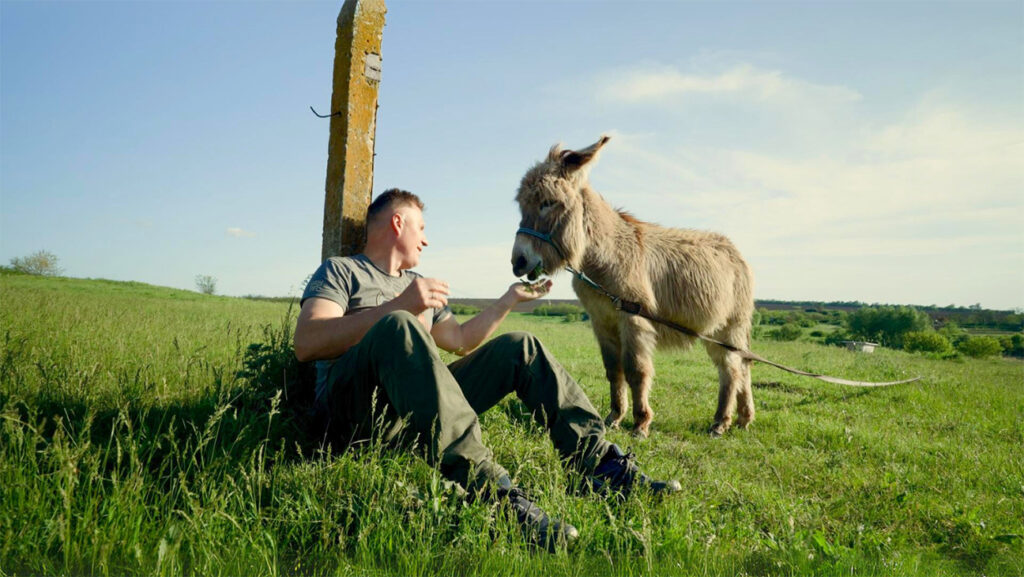With its handsome widescreen cinematography, its photogenic human subjects and its captivating assortment of farm animals, The Ark is a warm, inviting documentary. That would perhaps make it unremarkable if it weren’t also the case that Green Grove Farm, the auspiciously named homestead at its center, is situated in war-torn Ukraine.
With one eye on the ever-encroaching conflict, directors Jeremy Chilnick and Viacheslav Rakovskyi manage to maintain a mostly lighthearted mood as they follow the owners of that farm, a couple of former urbanites whose sense of rural community takes on a new scope as they open their property, and their hearts, to animals abandoned and injured in the midst of war.
The Ark
The Bottom Line
Straightforward and engaging.
Venue: Woodstock Film Festival
Directors: Jeremy Chilnick, Viacheslav Rakovskyi
Screenwriter: Jeremy Chilnick
1 hour 34 minutes
The helmers cycle through a year’s worth of seasons for Zhenya and Anatolij Pilipenko, inexperienced farmers who envisioned a new life for themselves and their two young daughters. Planning to make and sell cheese and enjoy the traffic-free surroundings, they bought a sizable piece of acreage in eastern Ukraine and left behind their city lives and careers, vaguely summarized here: Anatolij was an importer-exporter of raw materials, and Zhenya worked in the auto industry. A year after their move, the Russian invasion of Ukraine began.
“We didn’t understand where the frontline was,” Zhenya says, her voice even but her gaze betraying a sense of alarm. At one point she notes the physical effects of the stress on their younger daughter. A mostly unspoken tension between disaster and normalcy courses through The Ark.
Zhenya and Anatolij exude pride and delight when offering an inventory of the animals at Green Grove. The menagerie began with a neighbor’s three dozen goats; he’d been drafted and needed someone to care for them. A year later, more than 800 animals of all shapes and sizes called the Pilipenkos’ land home, among them a bull, cows, sheep, chickens, peacocks and pigs, most of them brought there by the military, some by animal welfare organizations. By the end of the documentary, that number has grown to 1,200.
For the couple and the farm’s young veterinarian, Natalia, responsibilities include coordinating rescues of stranded and hurt animals. “Saving Private Foal” is what Anatolij dubs their mission to reach a horse on the other side of an area that’s being shelled. The case of Mamulya, a donkey whose hoof was shattered, apparently in a mine explosion, becomes central to the story, emblematic of the assistance the sanctuary receives from within and beyond Ukraine’s borders in order to provide state-of-the-art medical treatments. Watching the donkey at the receiving end of such care and attention, it’s impossible not to think of the classic film parable Au Hasard Balthazar and its progeny EO, with their donkey-centric visions of human foolishness and cruelty and occasional compassion.
First-time directors Chilnick, the doc’s writer, and Rakovskyi, who handles DP duties, take a straightforward approach, working mostly in vérité, with occasional to-the-camera interviews interspersed. The English-language narration, delivered by Kyra Sedgwick, is used for sporadic, jarring and rarely necessary info drops, and would have felt more at home on the soundtrack of a PBS nature series. Audio from American and British news reports provides occasional updates on the war, but The Ark avoids any geopolitical analysis or point-making.
If the Pilipenkos’ resolve and resiliency are meant to be emblematic of a particular national identity or an expression of patriotism, it’s rather the universality of their story that impresses, their openness and humor. Mainly the doc, which took its world premiere bow at the Woodstock Film Festival, is concerned with showing how relatable Anatolij and Zhenya are as they face the challenges of running a family business, and how, within trying circumstances, that business takes on a greater purpose. Day to day and season to season, Zhenya totes up their growing financial needs, and they apply for international grants. Eventually they’re able to open Green Grove to visitors — specifically, to displaced people, returning soldiers and the families of soldiers killed in the war. More than a cheese market, more even than an animal sanctuary, the farm becomes a rehabilitation center for a war-scarred population.
Rakovskyi’s camerawork is especially dynamic during a sequence that closely follows animal rescue efforts in the flooded area around the Dnipro River after the June 2023 destruction of a dam (Ukraine and Russia blamed each other for the devastation, which displaced thousands of people). Anatolij is enthusiastically part of that heroic and delicate mission. At other points in the film, he seems almost apologetic about his focus on rescuing animals when people are also in harm’s way, or at least seems to feel that his choice requires explanation. Zhenya notes with quiet concern that he’s been playing patriotic music at home and has mentioned a desire to join the military counteroffensive.
The explanation that Anatolij offers for his focus on saving mammals and birds is at best unneeded. He does it, he says, because “they are Ukrainian animals.” But that feels precisely wrong. Among the many irresistible qualities of Mamulya the donkey, her fellow residents of Green Grove sanctuary and every other animal on Earth, there are these: They don’t wave flags and they don’t wage war.

